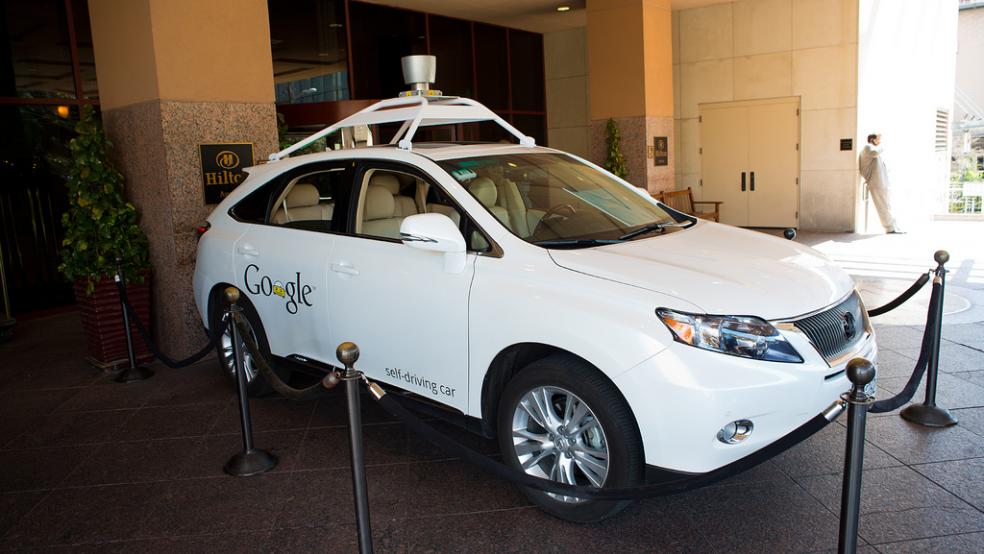Self-driving cars – the stuff of science fiction for decades – will be here within the decade, but several of their key features are already on sale in today’s new vehicles.
For instance: General Motors’ Range Adapted Cruise Control (latest edition) takes the car from 70 mph to zero without any help from the driver. Park Assist allows cars to self-parallel park, and already exists in many Ford and GM models.
RELATED: THE HIGH-TECH FUTURE OF CARS
Rear Cross Traffic Alerts stop a car before it backs into a building or pedestrian. Active Lane Keeping is a new technology that uses cameras to read the yellow lines and keep the car in its lane – while Lane Departure Warning beeps when a driver drifts. GM already offers most of these “embedded real time” technologies as part of its Super Cruise package in its Cadillac XTS and ATS models.
According to Bill Visnic, an auto industry analyst at Edmunds, the Mercedes S class and the Infinity Q50 offer similar packages, but he places GM in the lead among the Big Three carmakers. “They are fully engaged in the luxury market, and any big innovation usually starts in the luxury market and trickles down from there. Plus they have a dedicated innovation department.”
CONSUMER ENGAGEMENT
Consumers are increasingly getting on board. Last year, 40 percent of car buyers were interested in semi-autonomous features, such as emergency braking and steering, and 32 percent were interested in automatic park assist, according to the 2013 U.S. Automotive Emerging Technologies Study released last month by J.D. Power and Associates.
RELATED: A SELF-DRIVING CAR IN YOUR GARAGE IN 10 YEARS
Experts predict the first fully AV cars to hit the road by 2020, but even those will have a human component. The system will operate somewhat like an airplane’s autopilot, with a human driver able to override the computer or go hands free at will.
And the auto manufacturers aren’t the only ones that are road-testing the technology. The Google Car, a converted Prius, is the poster-droid for the industry. Google claims to have road tested it over 500,000 miles in California and Nevada, where the company has pushed for legislation allowing for such trials. And a team from Carnegie Mellon University (CMU) has spent seven years on its AV, a converted Cadillac SRX.
MAKING THE ROADS SAFER
Competition has intensified in the last two years, says Dan Gage, of the Auto Alliance, an industry lobby that represents 11 automakers. As tech egos swell and recede, along with market share – depending on who is first and best in class – this race has a revolutionary common goal. If they succeed, lives will be saved.
“We want to make cars that don’t crash,” says Dan Flores, a GM spokesman. That may sound outlandish, but Flores says the industry moved into what he calls “active safety technology” twenty years ago with the advent of anti-lock brakes.
That’s a lofty goal, and one that’s still far off. Though Google may have driven 500,000 miles, the current rate is a fatal car crash every 100 million miles. “That’s not even even a data point yet,” says Richard Wallace, of the Center for Automotive Research. “It’s got to work in every environment, from driveway to parking lot, and we’re far from that. Camera-based systems don’t work at all in the snow, and they don’t work that well at night.”
RELATED: THE ROBOT REVOLUTION: YOUR JOB MAY BE NEXT
Raj Rajkumar, who is heading up the CMU team, agrees that his next challenge is to get his car to work in heavy weather and in tunnels where there is no GPS. He admits that even with most of his systems in place, humans will need to be at the wheel for the next ten years. His concern is that humans are, well, human.
“We get distracted, and 90 percent of accidents happen because of human error,” he says. “Once people trust the technology, it will be safer if the human is not in the loop.”
Bryant Walker Smith, a research fellow at the Stanford Law and Engineering schools, isn’t as certain. “Nobody knows how safe these vehicles are, how safe they need to be, and how you go about measuring and demonstrating that.”
He agrees that human error is responsible for 30,000 traffic fatalities and accidents that injure over a million people each year. “But even if self-driving cars are ten times better than that, people are still going to be upset.” It could also be a legal nightmare for manufacturers and insurers. “I don’t think anyone should bet against technology,” says Smith, “but it will be gradual.”
OBSTACLES EXIST
A major barrier to taking AVs mainstream is the cost, says Wallace, who estimates that an AV will eventually start at $150,000. “The biggest hurdle is bringing the price point down, so it’s feasible on a mass scale. Then you have to get the regulatory regime to catch up.”
Trouble is, states have different rules when it comes to AVs and there is no federal AV legislation at all. There’s also the issue of infrastructure. In a perfect world, the cars aren’t just self-driving but communicating with the environment, and one another, to keep a safe distance.
Traffic lights and caution signs would issue advance warnings as code. But when the federal government can’t even agree on spending deals to repair degrading bridges and tunnels, it may be unreasonable to expect such an investment.
Wallace doesn’t see that as an issue. Although smart traffic signals would have to be installed – a process already underway in many cities, including Pittsburgh – he believes most of the vehicle-to-vehicle and vehicle-to-infrastructure conversation can happen via the existing cell phone network.
“The federal government won’t have to build anything,” he says. “Verizon already built it.”




